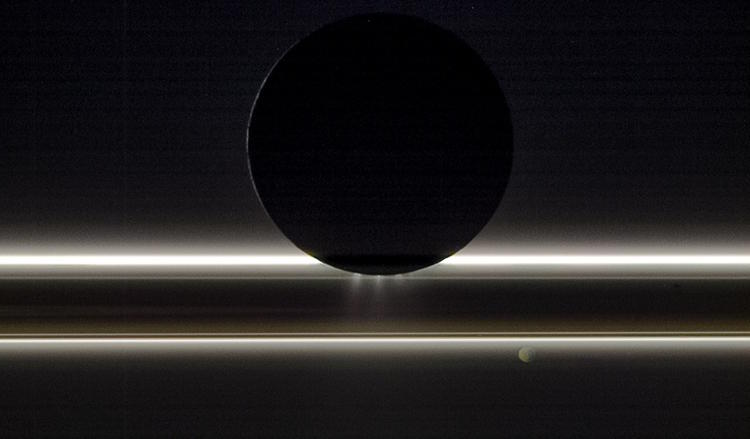
Okay, okay, it’s cheating, I know, since I’ve featured this very same moon before, taken by the very same probe as well. Of course, for the time being, there’s not a lot of choices in the latter department, since the Cassini probe was the only one doing detailed images of Saturn and its moons, but last September it boldly went down into the thickening atmosphere of Saturn and either got rendered inoperable by the pressure, or Bowmaned off into a new realm someplace – I’m fairly certain NASA is maintaining the former, but you know, they still maintain that we’ve actually been to our moon…
Anyway this is, once again, Saturn’s moon Enceladus, still showing off its fancy plumes, backlit by the sun, backgrounded by Saturn’s rings, and accompanied in the frame (though not in proximity) by another of Saturn’s moons, Pandora. Astronomy Picture Of the Day from February 15th has the details, and a larger version of the image. This one looks like a digitally created abstract; add in a base color of blue fading into pink and you’d have a great representation of cosmic artwork from the eighties.
Enceladus is known for being composed of a thick ice crust over what seems to be an underlying, global, liquid ocean, which vents out into space through cracks in the ice crust; that’s actually what you’re seeing at the bottom of the moon. You might be thinking, How does a liquid ocean exist under the ice crust way out there around Saturn? Enceladus is close enough to Saturn’s strong gravity that the constant tidal forces on the solid core – the same kind of thing that gives Earth its ocean tides, but a hell of a lot stronger – actually keep it in flux and generate a fair amount of heat and friction, which appears to be enough to maintain the ‘mid-level’ water in liquid form – and it’s this same state that makes Enceladus one of the biggest candidates for life to form within our solar system. Determining this could be tricky, since that ice crust is kilometers thick – right now we have the information we do about it through penetrating radar and gravitational measurements. One of the things that I hope we accomplish within my lifetime is actually getting some kind of probe down to the water level of that moon.
Now an examination from the photographic standpoint. You may have noticed that Enceladus is entirely silhouetted except for the barest edge, but Pandora has its face illuminated by sunlight reflected from Saturn. Why not Enceladus? Because we’re looking at the ‘double-night’ side of Enceladus – it’s closer to Cassini (and our viewing position) than Saturn is, while Pandora is on the opposite side of the orbit; the sun itself is directly behind Enceladus, thus the glowing ring lines across the image, while Saturn is out of the frame to the left. Sunlight reflected from Saturn can illuminate Pandora, and it illuminates Enceladus too, making it much brighter than Pandora – but on the side opposite us.
I said ‘double-night’ above to reflect the light dynamics around other planets. On Saturn’s moons, the sun can be very bright, but it’s so distant as to be quite small in the sky, while the vast bulk of Saturn itself – and Jupiter, and Neptune, and so on – will dominate the sky, and throw a lot of reflected light. So Pandora, between the sun and Saturn, is lit from two sides, and only a narrow sliver of the moon might be experiencing darkness. But as it moves around to the night side of Saturn, the far side can experience true night, like this face of Enceladus is now. The ‘day-night’ cycle of the moons is distinctly different from our own, where our little and somewhat distant moon can brighten the night at times, but not as badly as something taking up literally half of the entire sky as Saturn might.
And yes, Earth throws reflected sunlight onto the ‘dark side’ of our own moon as well, but a) it mostly does it during our local day so the light scattered from our atmosphere obscures most of it, and b) it’s weak in comparison to Saturn – consider how small the Earth looks in those photos taken from the moon. But in the right conditions it can still be captured – check out ‘Earthshine’ sometime.




















































